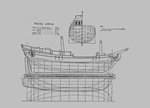|
Introduction
This paper presents a survey of the literature covering the more
significant papers about the Gaspee
uncovered to date and the more general ship construction and rigging
practices of the mid-eighteenth century. I have attempted to synthesize
the available information and draw my own conclusions about what can be
determined today about the actual construction and rigging of the Gaspee as of the time of her
burning in Narragansett Bay.
Background
"In January 1764, the Admiralty began buying schooners for service
mostly along the New England coast…Hence, the Admiralty ordered the
Navy Board to obtain six "Marblehead schooners or sloops" to be named Chaleur, Gaspee, Hope, Magdalen, St. John,
and St. Lawrence…." The
Navy List shows these vessels to have been nearly alike in size: Magdalen 90 3/94; Gaspee, 102 44/94; Hope, 105 40/94; St. John and St. Lawrence 114 65/94 and Chaleur 116 91/94. Chaleur is the only one of these
vessels for which Admiralty draughts are known to exist.
The name "Marblehead" is generally accepted today as indicative of
vessels built only in Essex County, Massachusetts. Chapelle and
others indicate that this definition was also true during the
eighteenth century. The Admiralty papers, as reported by
Chapelle, reference "Essex" as one of two areas on the North American
coast that were recognized as centers for building fast sailing
vessels. Hahn, on the other hand suggests that to the Admiralty
and their purchasing agent Colville, a looser definition was in
operation.
Hahn presents much of a long letter from Admiral Colville, writing from
Halifax Harbor, to Philip Stephens, Secretary of the Admiralty
detailing the progress in acquiring "six Marblehead Schooners or
Sloops". I quote in part "on the 27 Directions were sent to
Boston, by the Naval Officer, for purchasing three of the best
Marblehead Schooners or Sloops, from Seventy to ninety Tones that could
be procured, to be delivered at this Place." In a later letter,
Colville identifies the three as Magdalen,
Schooner, 90 3/94 tons; Chaleur,
Sloop, 116 91/94 tons; and St. John,
Schooner, tonnage unknown.
Further in Colville's letter, he goes on to say "Besides these, two
Schooners were purchased at this Place which are now fitting out, at
the Yard, in the manner directed by their Lordships: They are very fine
Vessels between Ninety and a hundred Tons each; one of them was built
last Fall at a new Settlement of this Province called Chester, twelve
Leagues to the Westward of Halifax… I expect another Schooner that is
ready to be launched at the same Place which will compleat [sic] the number of six. In
the later letter, he identifies these vessels as; Hope, Schooner, 105 40/94 tons; St. Lawrence, Schooner, 114 65/94;
and Gaspey [sic], Sloop, 102 44/94.
From Colville's letter we then have three vessels, not including the Gaspee, which were purchased at
Boston, where they were built unknown. We also have three
vessels, including the Gaspee,
which were purchased at Halifax. One of them is not identified to
her place of building. One of them positively identified as being
"built" at Chester which was probably Hope
since her age was given as 9 months. There is a strong suggestion
that a third vessel is being built at Chester as opposed to just going
through a refit, by the comment "I expect another Schooner that is
ready to be launched at the same Place which will compleat [sic] the number of six". Of
the vessels procured in Halifax, Colville already had two in hand at
the time of writing the letter and was waiting for the third. In his
letter, Colville states “this is the worst time of the year for
buying such Vessels, as most of them are fitted out for the Summer’s
Fishing when that Season is over they become plenty and cheap”.
In his final tabulation of vessels purchased at Halifax, Colville had
two schooners and a sloop, not the three schooners he had originally
reported. The Gaspee
was reported as the "sloop" and her age of 1 year 7 months prohibits
her consideration as being the vessel that was under construction at
the time the first letter was written. Evidently, Colville bought
a different vessel rather than wait for the one that was not yet
launched.
What we are left with is six vessels that were built between 1761 and
1764 somewhere between Halifax and Boston, give or take a few miles
further north or south, that in the eye of Admiral Colville and his
aids fit the description "Marblehead schooner or sloop".
Hull Form
 Left: Draught of Chaleur, courtesy of the Joseph Bucklin Society
website at http://www.bucklinsociety.net Left: Draught of Chaleur, courtesy of the Joseph Bucklin Society
website at http://www.bucklinsociety.net
Click image to enlarge.
Reliable
draughts
exist only for the Chaleur out
of the six ships in question. Draughts are also available for two ships
of the same period, the Halifax
and the Sultana. The only extant
dimensions recorded for the Gaspee
are her tonnage (102 44/94), length of keel (49), extreme breadth (19’
10”) and depth of hold (7’ 10”). Smith and Gilmer estimate the length
on the keel to be 46-52 feet, LOA 63-68 and beam 19-21 for a vessel of
100 tons. Although the Gaspee
dimensions compare favorably to the estimates, the estimates represent
a composite of the known hull forms of the period. Knowing exact
dimensions does not give an indication of the hull form without
comparison to other vessels. The following table shows the dimensions
to Gaspee, Chaleur, Halifax and Sultana.
| Ship |
Tonnage |
Keel |
Range of Deck |
Beam |
Hold |
| Gaspee |
102.47 |
49.00 |
68* |
19.83 |
7.83 |
| Chaleur |
116.97 |
50.00 |
70.67 |
20.33 |
7.29 |
| Halifax |
106.50 |
46.88 |
58.25 |
18.25 |
8.83 |
| Sultana |
52.62 |
38.46 |
50.5 |
16.06 |
8.3 |
* Estimate by H. Chapelle, letter
dated 20 December 1966 to David Stackhouse, Gaspee Days Committee
Left: The lines and outboard
profile of the Halifax,
(misspelt as Hallifax on this draught) an
American-built
commercial
schooner c1765. The plan shows a small and rather slow carrier. Note
the
fullness of the waterlines and buttocks at bow and stern. From Chapelle's The
History of American Sailing Ships,
p34-35. Click to enlarge
images.
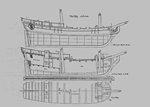 Right:
Halifax, upper
portion shows the outboard profile
of this schooner as altered for the Royal Navy. The lower portion shows
the inboard details of the schooner before the alterations were made in
her rails. Note the method of fitting the hawse-holes below deck level,
an item of construction rarely seen in the period in which this
schooner
was built. Right:
Halifax, upper
portion shows the outboard profile
of this schooner as altered for the Royal Navy. The lower portion shows
the inboard details of the schooner before the alterations were made in
her rails. Note the method of fitting the hawse-holes below deck level,
an item of construction rarely seen in the period in which this
schooner
was built.
The Gaspee compares favorably to the Chaleur and is not too far off from
the Halifax. Either of these
vessels are candidates for possible Gaspee
hull shapes. Because of the relationship between size and hold
capacity, the Sultana is
unlikely to provide insights into the shape of the Gaspee’s hull. In addition to the Chaleur and Halifax drawings, there are extant
wrecks of vessels similar in size from the same period. The wrecks
exhibit similarities to Chaleur
but also exhibit differences that are significant to the actual shape
of the hulls. In some instances, the evident similarities to Chaleur may be a consequence of
the archaeologists using the Chaleur
draughts to lay out their survey grid as was done with the
Terrence Bay Wreck. Taken together, the available evidence leaves a
wide variety of possible hull shapes for the Gaspee.
 Left: Drawing of Chaleur, courtesy of the Joseph Bucklin Society
website at http://www.bucklinsociety.net Left: Drawing of Chaleur, courtesy of the Joseph Bucklin Society
website at http://www.bucklinsociety.net
Click image to enlarge.
Some insights
into
selecting an appropriate hull shape could be gained if it could be
determined the purpose for which the Gaspee
was built. Each purpose (e.g., fishing, merchant, transport, privateer
and so forth) tends to favor particular design characteristics. Prior
to the eighteenth century, hull design was general in nature and ships
were built with no particular purpose implied in their design. During
the eighteenth century, more attention was paid in the design toward a
particular occupation, but even then, many vessels served in more than
one occupation. Coleville’s letter gives the information that most of
the vessels procured were “fitted out for the Summer’s fishing” which
implies that in 1763 vessels were still being fitted out differently
for different occupations during different seasons. Chapelle suggests
that Chaleur was built as
both a merchant and a fishing vessel, a common combination from the
period. Gaspee may have been
similarly employed and the economic conditions of the time favor that
conclusion.
One significant clue both Hahn and Morris offer is that in the colonies
during that period, the terms “sloop” and “schooner” were most likely
references to particular hull forms rather than rigging. Morris quotes
Blanckley (1750) as follows: “Sloops are sailed and masted as Men’s
Fancies lead them, sometimes with one Mast, with two, and with three,
with Bermudoes, Shoulder of Mutton, Square, Lugg, and Smack Sails; they
are in Figure either square or round Stern’d.” Morris further
elaborates the issue by stating “three names [in American usage],
sloop, ketch and schooner, do after about 1700 carry with them a
moderately clear association with particular rigs.” Of the six vessels
purchased by Colville, only the Chaleur
and Gaspee are
identified as sloops however, there is no evidence suggesting the
context (hull form or rig) that Colville used in identifying the vessel
types at the time of their purchase. There is evidence that their rigs
were changed from sloop to schooner rigs at some time after being
brought into the navy so at least the context of rig may be assumed.
An additional clue is given in Morris in his identification of vessels
owed at Newport, Rhode Island in 1764 from the Itineraries of President
Ezra Stiles of Yale College. At that time, there were 50 sloops of
average tonnage 60 and 7 schooners of average tonnage 45. This suggests
that for vessels large enough to be noted, sloops were as a class,
larger than schooners. Morris also presents statistics from
Philadelphia from the 1730 Foreign Documents that show the same
characteristics. Unfortunately, all six of the vessels purchased by
Colville are of approximately the same tonnage.
Considerations:
- Gaspee and Chaleur were built within eight
months of each other. This is too short a period for substantial
changes in ship building technology to have come into play.
- Some
variation in
hulls built from the same design can be expected, particularly if they
were built in different yards, but significant variation from type are
unlikely.
- There is no
direct evidence that Gaspee and
Chaleur were of the
same
design.
- Gaspee and Chaleur were approximately the
same size, proportions and tonnage. Size and proportions do not exclude
the possibility of extreme differences in hull form, particularly below
the water line, but nearly equivalent tonnage limits the variation
significantly.
- Gaspee and Chaleur were both identified as
sloops while the other four were identified as schooners.
- Gaspee and Chaleur are known to have been
sloop rigged at the time of purchase.
- Colville,
in
identifying the types of vessels he purchased, may have been referring
to the hull form, the rig or both.
Conclusion: Only
the barest of threads, the definition of sloop used by Colville in
identifying the types of vessels he purchased, connects the design of
the Gaspee to the design of Chaleur. Colville’s definition in
this context is unknown. Without further evidence, the hull form of the
Gaspee cannot be
determined
definitively.
Above the Waterline
Two aspects of a vessel define what she looks like to the casual
observer, her rig and what she looks like above the load waterline. The
characteristics of her look above the waterline include her poop deck,
quarterdeck, bulwarks, rails and the type and placement of the deck
furniture and armament. The unfortunate reality is that for vessels of
this period of the size of the Gaspee,
there is a wide range of possible variation in these characteristics.
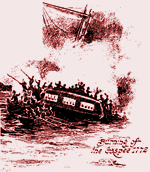 Left:
Early woodcut of the attack on the Gaspee, artist unknown. Click image to
enlarge Left:
Early woodcut of the attack on the Gaspee, artist unknown. Click image to
enlarge
Poop Deck:
The oldest extant artistic representations of the Gaspee depict a somewhat oval
transom that exaggerates the curve of the tumblehome. Vessels from the
same period that have a poop deck typically have a change in shape in
the transom that becomes more vertical from the stern view as it
transitions over the end of the poop deck. This transition does not
appear in the oldest artistic representations of the Gaspee and suggests that she did
not have a poop deck. Note that the term “poop deck” was often confused
with the term “quarterdeck” during the period. In this discussion, I
use the term “poop deck” to mean an additional deck in the stern, above
the quarterdeck.
Considerations:
- Contemporary
artists were the “photographers” of their day.
- Contemporary
artists could no more misrepresent a ship than they could a house or a
horse and still stay in business.
- Contemporary
artistic representations of ships may be lacking in small detail, but
in major features may be relied upon.
- None of the
oldest extant artistic representations of Gaspee have been proven to be
contemporaneous.
- Non-contemporaneous
artistic representations tend to be less accurate, the more so as they
become further removed in time.
- Non-contemporaneous
artistic representations may have been intended to emphasize some
aspect of an event other than the vessel involved and to do so in a
manner that increases the perception of degree of difficulty of the
event or the relative importance of the participants.
- The oldest
known
artistic representations agree on major features of Gaspee to a significant degree
although it is possible that they are all reproductions in various
forms of a single, undated woodcut.
Conclusion: The
oldest known
artistic representations suggest that Gaspee did not have had a poop
deck.
Quarterdeck:
Quarterdeck height ranged from mid-shin height to waist height on
vessels of the size of the Gaspee.
In length, they varied from mid-way between the stern and the mainmast
to just forward of the mast. Extant artistic representations give some
indication of the height of the Gaspee’s
quarterdeck. An old woodcut (provenance and exact age unknown but older
than 1856) shows the rounded top to the transom as shown on the plans
of the Chaleur which is known
from the Admiralty draughts to have a high quarterdeck. The people
depicted standing on the quarterdeck are shown well above the waterline
also indicating a high quarterdeck.
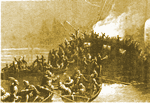 Left: Destruction of the
Schooner
Gaspé by J. McKevin,
Engraved by
J Rogers Left: Destruction of the
Schooner
Gaspé by J. McKevin,
Engraved by
J Rogers
engraving
based on earlier woodcarving Found in History of New York, c1872. Click image to enlarge
Hale
reproduces a
steel engraving by J. Rogers which was published in 1856. The
engraving was identified as "after a painting by J. McNevin, from the
Rhode Island Historical Society. The engraving shows the stern
view with marked tumblehome, three widely spaced stern lights and men
standing on the cabin top. The line of the cabin top appears
slightly rounded.
Considerations:
- The length
was
most likely less than the distance between the stern and the mainmast
since she was brought into the British Navy as a warship. A longer
quarterdeck would have interfered with the placement of carriage guns
and would be an unlikely choice.
- A high
quarterdeck is more suitable to providing adequate headroom in the
officer’s quarters.
Conclusion: The
Gaspee probably had a
high
quarterdeck that extended somewhere between one-half and three quarters
of the way between the stern and midship.
Bulwarks:
Most merchant vessels of the period had no true bulwarks in the waist
but rather had bulwarks less than a foot in height. The quarterdeck and
sometimes the forward end of the vessel were edged with a railing.
Fishing vessels, since men fished over the side, typically had a
bulwark in the waist. Small warships sometimes had half-height bulwarks
with notches for the guns similar to the crenellations on a medieval
castle. Others had bulwarks high enough to support the installation of
true gun ports.
Considerations:
- Bulwarks
provide
purchase points for gun tackles.
- Bulwarks
provide
a psychological benefit to the gun crews.
- The Chaleur is shown with full height
bulwarks in the Admiralty draughts.
Conclusion: The
Gaspee probably had
bulwarks
of significant height in the waist after being refitted for use by the
Royal Navy.
Deck Furniture:
Deck furniture provides support for various activities on the deck such
as piloting the vessel, hoisting cargo, sails and anchors and access to
the below deck areas. For any given function, the form and location of
the item could vary, but with some limitations. The companionway for
the aft cabin was unlikely to be mounted in the bow or the mechanism
for hoisting the anchor located in the stern. For a vessel the size of
the Gaspee, there were some
choices that were likely to be preferable to others as indicated below.
Considerations:
- The rudder
was
probably controlled by a tiller, well aft, rather than a wheel. Wheels
of the time tended to have significant play and took up more room than
a tiller alone. Unless a vessel required significantly more mechanical
advantage than offered by a tiller of reasonable length to hold a point
of sail, a wheel was impractical.
- There
was
probably a windlass, rather than a capstain, mounted well forward. It
was probably mounted just abaft the foremast. A capstan was probably
not used due to its requirement for more space to operate than is
needed for a windlass.
- A large
main
hatch was probably just forward of the mainmast. A means of accessing
the hold were required regardless the occupation of the vessel. A
centrally located hatch would give equal access to all parts of the
hold.
- A
companionway to
the cabin was probably installed just aft of the forward edge of the
poop deck. The captain of a vessel needed to be provided with ready
access to the deck from the cabin, particularly in times of imminent
danger to the vessel. That access isn’t likely to have been positioned
such that it encroached on the available cabin space.
- A binnacle
was
probably just abaft the cabin companionway and forward of the forward
end of the tiller. The compass needed to be readily visible to the man
at the helm.
- There may
have
been a cable locker hatch on one or both sides of the bowsprit. Except
in very small vessels, cables were stored below deck. At least one
cable locker is needed. Two is more likely since a vessel of 100 tons
most likely carried a backup anchor.
- There were
likely
to have been one or two elm tree pumps mounted just forward of or on
the quarterdeck. Ships leak. Some means of removing water from the
bilge was needed. Most vessels of the period had a bilge that was lower
in the stern than in the bow. Simple elm tree pumps are most likely for
vessels of the size of the Gaspee.
Conclusion: The
generalities
unfortunately, do not give much insight into the details.
- The
companionway
into the cabin may have been no more than a sliding hatch mounted on
the forward end of the quarterdeck. It may have been a deckhouse
mounted somewhere between the tiller and the forward end of the
quarterdeck.
- The
binnacle may
have been a separate structure or may have been attached to the aft
side of a deckhouse depending on the configuration of the companionway.
- The
literature
indicates that exact placement, shape and size of the deck furniture
was somewhat subject to the whims of the builder during construction or
refit and afterwards, to the whims of the captain.
- There is no
reason to suspect that the deck furniture differed in kind from the
generalities, but there is too much variation possible in actual form
to determine what it looked like on the Gaspee.
Armament:
Bacon reports the Gaspee as a
"schooner of eight guns" but gives no attribution or indication of
their size. Colville’s letter of 19 May 1764 states that he had
commanded the frigate captains to turn over their 3-pounders and part
of their swivels for use on the schooners. Hahn further elaborates that
the difficulty the schooners had in dealing with the smugglers was at
least in part due to their light (3-pounder) armament.
Dudingston claimed at his court martial that he could not train his
guns on the attackers because they were too close to the Gaspee when noticed. This suggests
that the Gaspee was not
equipped with swivel guns since they can be depressed to fire almost
vertically. However, Colville’s letter of 19 May 1764 included swivel
guns.
Considerations:
- Colville’s
letter
gives explicit reference to the size of carriage guns for the Gaspee.
- Eight guns,
mounted in the waist is reasonable for a vessel the size of the Gaspee.
- Guns were
hard to
come by on station. Eight guns may have been desirable, but there might
not have been enough available to meet that goal.
- Swivel guns
were
usually part of the armament of British naval vessels of all sizes
- Duddingston’s
claim of an inability to train guns on the attackers should not be
interpreted to indicate the lack of swivel guns but rather as an
attempt by Dudingston to provide a possible explanation for an apparent
lack of readiness on the part of his officers and crew.
Conclusion:
- Six to
eight
3-pounder guns is a reasonable estimate for the carriage gun armament
of the Gaspee. The carriage
guns were most likely mounted in the waist.
- She was
most
likely also armed with swivel guns mounted on the rail of the
quarterdeck and possibly at the bow.
Rigging:
On the issue of whether "schooner", in reference to rig, meant the same
then as it does now, Morris suggests that at least for Colonial
America, it did, at least in its reference to the number of masts
involved. He claims that the distinction of schooners having two
masts and sloops having one was well part of the local lexicon by mid
century. The oldest extant artistic representations of the Gaspee as of the time of her
burning show her as schooner rigged.
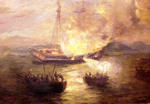 Left: The
Burning of the Gaspee by Charles
DeWolfe Brownell, c1892. Painting courtesy of the Rhode Island
Historical Society. Click image to enlarge Left: The
Burning of the Gaspee by Charles
DeWolfe Brownell, c1892. Painting courtesy of the Rhode Island
Historical Society. Click image to enlarge
The oldest
artistic
representations of the Gaspee
show her as carrying a fore-and-aft sail on both the main and fore
masts and a jib. A square sail mounted on a spar crossed on the
foremast is also shown. There is no spar shown on the main mast. None
of the older artistic representations show a spar crossed on the
mainmast. Both the old woodcut and the later picture by Charles DeWolfe
Brownell (1892) show true topmasts for both the fore and main masts
rather than pole masts. The topmasts appear to have been intended to
support staysails rather than topsails since no yards are shown. This
may however be no more than the particular rig chosen by Dudingston
while cruising Narragansett Bay. Topsail yards were often struck when a
topsail was not needed to meet the sailing conditions at a particular
point in time. Staysails, in light airs, are more useful in the general
sailing conditions of Narragansett Bay than topsails.
May reports testimony to the effect that "One of the boats came
alongside under the starboard fore shrouds". The existence of
shrouds, both fore and aft, are to be expected in a vessel of this type
and period.
The Gaspee was purchased into
the British navy as a sloop that was later converted to a schooner.
This is a reasonable conversion for the period, particularly when there
was inadequate crew for the vessel. Sloops require a larger crew than
do schooners of the same size due to a sloop having a single, very
large mainsail in comparison to the schooner’s smaller fore and main
sails. Coleville indicated in his letter to the Admiralty that he was
having difficulty obtaining an adequate number of skilled seamen to man
the fleet.
The references to the Gaspee
being a schooner describe a vessel whose rig falls within the
parameters established by the oldest known artistic representations.
Considerations:
- All
references to
the Gaspee, at the time of
her burning refer to her as a schooner.
- The term
schooner, as applied to rig, was at the time equivalent to the usage of
the term today.
- The basic
schooner rig supports a fairly broad set of optional sail plan
configurations depending on the prevailing weather conditions.
- All
reasonable
artistic representations of the Gaspee
depict a schooner rig.
Conclusions:
- The oldest
artistic representations are probably a reasonable estimate of the
rigging configuration of the Gaspee
at the time of her burning.
- The
configuration, at the time of her burning, does not preclude other
configurations she might have carried at other times, that still remain
within the definition of schooner as applied during the period.
Summary of Conclusions
Some reasonable assumptions may be drawn from the available
documentation about the Gaspee’s
construction and rigging. These are however limited to her rig,
armament and generalities about all other aspects of the vessel. The
exact hull form of the Gaspee
has been lost to history, as have most of the details of her
appearance. There are too many gaps in what is known to be able to
definitively describe the Gaspee
to the degree necessary to build a truly representative model or
reconstruction. |
References:
Bacon, Edgar
Mayhew, Narragansett Bay, It's
Historic
and
Romantic Associations, 1904
Biddle, Randle
M,
Personal correspondence with the author.
Chapelle, Howard J. The Search for
Speed Under Sail, W. W. Norton & Co, 1967 Library of
Congress Catalog Card No. 67-11090
Chapelle, Howard J. The History of
American Sailing Ships, W. W. Norton & Co, 1935
Christopher Champlin Papers, Rhode Island Historical Society,
Manuscripts Divison
Hahn, Harold M., The Colonial
Schooner 1763-1765, Conway Maritime Press, 1981
Hale, Stuart O, Narragansett Bay, A Friend's Perspective,
Maritime Advisory Service, NOAA/Sea Grant, Marine Bulletin 42
Harland,
John.,
Personal correspondence with the author
Kenchington, T. J., "An 18th century precursor of the fishing
schooner's 'great beam' or 'break beam'?, The Journal of Nautical Archaeology,
1994 23.1
Kenchington,
T. J.,
Personal correspondence with the author
May, W. E., "The Gaspee Affair", The
Mariner's Mirror, Vol 63 No 2, May 1977
Morris, E. P., The Fore-and-Aft Rig
in America, Yale University Press, 1927
Smith, Melbourne and Gilmer, Thomas C, “The Colonial Brig Peggy
Stewart”, Nautical Research Journal,
Volume 19, No. 4.
Significant Paintings and
Drawings:
Note: Only the oldest provenance sources are considered. More modern
renditions deemed by the author to be too fanciful for colonial built
vessels, even after refit for the British Navy, have not been
considered. Also dropped from consideration are those that lack
sufficient detail to be of use.
|
 Virtual Archives
Virtual Archives Right:
Halifax, upper
portion shows the outboard profile
of this schooner as altered for the Royal Navy. The lower portion shows
the inboard details of the schooner before the alterations were made in
her rails. Note the method of fitting the hawse-holes below deck level,
an item of construction rarely seen in the period in which this
schooner
was built.
Right:
Halifax, upper
portion shows the outboard profile
of this schooner as altered for the Royal Navy. The lower portion shows
the inboard details of the schooner before the alterations were made in
her rails. Note the method of fitting the hawse-holes below deck level,
an item of construction rarely seen in the period in which this
schooner
was built.
